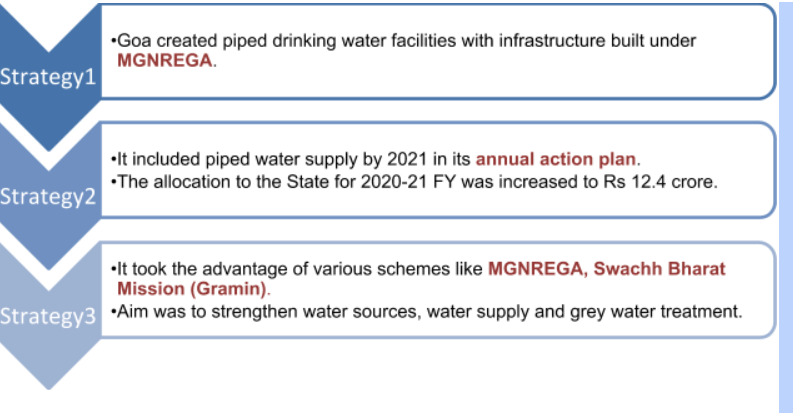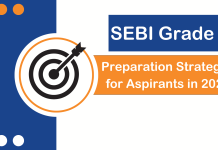Goa has recently been declared as the first ‘Har Ghar Jal’ state by the Ministry of Jal Shakti, which was formed in May 2019 by merging two ministries Ministry of Water Resources, River Development and Ganga Rejuvenation and Ministry of Drinking Water and Sanitation. It is a feat given to the coastal state for achieving 100% functional household tap connections (FHTCs) in the rural areas under the Central Government’s Jal Jeevan Mission.
Goa’s two districts- North Goa with 1.65 lakh rural households and South Goa with 98,000 rural households have now functional household tap connections. Let’s have a detailed information about Goa strategy that gave it ‘Har Ghar Ja’ status.
Goa’s 3-Pronged Strategy
According to the experts, Goa’s small size (areawise), the ready availability of water and high awareness even among the rural population are the few things that helped the state to achieve this feat. However, these fundamentals were not enough. The state administration adopted a three-pronged strategy described below-

Goa actively built the infrastructure for piped water connections under Mahatma Gandhi National Rural Employment Guarantee Act (MGNREGA). In addition to this, it set a target to achieve 100% piped water connection by 2021 and included this target in its State annual action plan. This helped the State to receive increased funding of Rs 12.4 crore for this purpose for the current Financial Year.
Lastly, Goa’s took advantage of various other schemes including Swachh Bharat Mission (Gramin) for increasing infrastructure of drinking water sources, water supply and greywater treatment.
Further Improvement
Reaching every rural household with piped water is not an end in itself. The State administration must take further steps for the smooth continuation of this feat and ensure good quality of piped water.
As of now, the State has planned to set up 14 water quality testing laboratories accredited by the National Accreditation Board for Testing and Calibration Laboratories (NABL). It also plan to have sensor-based service delivery monitoring system so as to monitor the functionality of the water supply. This would ensure an adequate quantity and prescribed quality of water supply.
The State will train five persons in every village, especially women, in using field test kits, thus empowering the most vulnerable gender and thus ensuring the water quality is tested locally by the rural households themselves.
Goa has become the first state to have achieved the 100% piped water coverage target under the ambitious Jal Jeevan Mission. Given below are some of the salient details of the flagship mission of the Jal Shakti Ministry.
Jal Jeevan Mission
Some Key Details-
| Launch Date | 15th August 2019 |
| Nodal Ministry | Ministry of Jal Shakti |
| Target | Supply of 55 litres of water per head per day to every household in rural areas through Functional Household Tap Connections (FHTC) by 2024. |
| Scheme Type | Centrally Sponsored Scheme 90:10 for Himalayan (Uttarakhand, Himachal Pradesh) and the North-Eastern States100:0 for UTs50:50 for rest of the States |
| Budget Allocation | Rs 3.60 lakh crore |
Jal Jeevan Mission’s main aim is to ensure a Supply of 55 litres of water per head per day to every household in rural areas through Functional Household Tap Connections (FHTC) by 2024. It focusses on integrated demand and supply-side management of water at the local level by creating local infrastructure like rainwater harvesting, groundwater recharge and management of household wastewater for reuse.
This mission also mandates for a community approach to water by imparting extensive Information, Education and Communication at the local level.
Jal Jeevan Mission Dashboard

Source– Ministry of Jal Shakti
As per the current data on 17th October 2020, almost 30% of rural households have been connected with tap water. Goa is the only state with 100% households with water tap connections, and there are only 16 districts in India with a 100% tap connection coverage in the rural households.
After Goa, Telangana stands second with 98.38% of its rural households having water tap connections. The worst three performing states are West Bengal (2.62%), Meghalaya (4.38%), and Assam (4.60%).
Hope you enjoyed regarding the article and it is very important for exams like NABARD Grade A and B, RBI Grade B etc where question are often asked from various government schemes. As RBI Grade B 2019 result are out and recruitment for 2020 can be expected soon so we have launched an exclusive RBI Grade B course to ace your preparation.
Also stay tuned for more such informative article
Also Read
Get Free Online Test Series, GK updates in form of Beepedia, BeeBooster, as well as latest updates for Bank PO, Bank Clerk, SSC, RBI, NABARD and Other Government Jobs.
екапуста займ на картузайм под материнский капитал челябинскзайм 1000 рублей на киви












